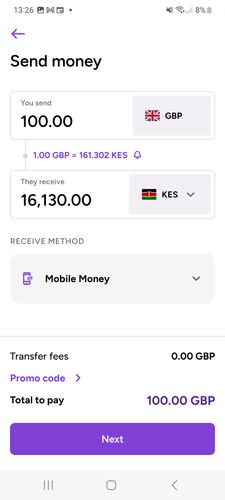Send money to India
"Over 16 million customers use Wise, mostly for their excellent mobile app, transparent fee structure & use of mid-market rates. Now increasingly used for larger transfers."
"Xe has over 30 years of currency exchange experience, and is one of the most reputable names on the market. 200 countries, 100 currencies, & funds often received in seconds."
"Over 16 million customers use Wise, mostly for their excellent mobile app, transparent fee structure & use of mid-market rates. Now increasingly used for larger transfers."
"Currencies Direct have over 30 years of global money transfer expertise. Award winning service with a TrustPilot rating of 4.9. Lock-in rates for the future or trade 24/7 on web or mobile."
"Revolut has 50+ million customers globally. You can hold up to 36 currencies in the app and send money quickly in 70+ currencies to 160+ countries."
"24/7 live chat support provided in six languages. Special first transfer rates available, with airtime topup supported to many countries in Africa, Asia and South America."
"OFX have been helping individuals and businesses send money for over 25 years. Transfer in 50+ currencies to 170+ countries, with 24/7 phone access to currency experts."
"Xe has over 30 years of currency exchange experience, and is one of the most reputable names on the market. 200 countries, 100 currencies, & funds often received in seconds."
"Regency's UK-based account management team has vast experience. Get support on all kinds of transfers, from overseas property transactions to business payments & more."
"Remitly focuses on sending money to friends and family in Asia, Africa and South America. Wide coverage and well-suited to regular transfers home."
"Xoom, a PayPal service, allows you to send money in more than 160 countries. You can send cash for over-the-counter pickup or home delivery, as well as send by bank transfer or debit card."
"Securely send money to and from 150+ countries and 20+ currencies. Same-day transfers avaialble on most major currencies."
"Fast, secure internatinal transfers with no fees and transparent rates. They offer a free currency card for use at home and abroad."
"Send money to over 40 destinations online and in the mobile app."
"Paysend has transparent fees and rates, with transfer sent within seconds to your recipient's bank. They also have global 24/7 support for any enquiries, and bank-level security."
"Moneygram is a well established service with over 80 years in the sector. They support over 200 countries worldwide and have over 440,000 retail locations."
The best way to send money to India: Wise
After reviewing and testing 20 money transfer providers supporting INR transfers, we found Wise to be the top choice for money transfers to India as of May 2025.
Wise appeared in 95% of INR transfer searches and ranked as the best option among providers supporting Indian Rupee transfers.
With quick transfers, a low markup of 0.01% on INR exchange rates, and a low fee of $133.69, Wise offers the ideal balance of cost, speed, and features for INR transfers.

How to get the best rate for money transfers to India
Consider this before sending money to India
India has one of the world’s largest remittance markets, and with so many options available, it’s important to compare providers before making a transfer.
Our live comparison includes 20 money transfer services that support transfers to India.
Based on recent data:
WorldRemit appeared in 97.4% of searches as the cheapest provider for INR transfers.
Wise also ranked as the fastest option in 1184 searches
While WorldRemit consistently offered the most competitive exchange rates.
Comparing your options can help you save on fees, improve delivery speed, and increase the amount of INR your recipient receives.
Cheapest way to send money to India: WorldRemit
If you want to make the most of your INR transfer, the cheapest way is to use WorldRemit and pay for your transfer with a Bank transfer.
Over the past 6-months WorldRemit appeared 97.4% of the time in our comparison as the cheapest transfer option to India.
With just $3 in fees and -4.61% markup, WorldRemit is % cheaper than the next best option.
Bank transfer is the cheapest deposit option to India, pair it with WorldRemit to receive the most INR.
*The transfer cost to India depends on the country of origin, amount of INR sent, payment method, and the exchange rate ‘markup’ on Indian Rupees.


Wise is the fastest way to send money to India
Wise appeared 52.4% of the time as the fastest money transfer company available in India.
They charge $39.8 and add a markup of 0% on top of the INR exchange rate. This is 0% cheaper than the next best option as of May 2025.
For the best combination of speed and cost, we recommend using a to fund your transfer to India.
*This is based on a $2,000 transfer to India and a 6-month analysis of our comparison data involving INR transfers.

The easiest way to send money to India: Wise
In our 6-month analysis, Wise ranked as the top-rated money transfer provider in 95% of the searches related to India.
They’re highly transparent with fees, charging $133.69 per transfer with a 0.01% markup on the INR mid-market rate.
With multiple deposit and withdrawal options and reliable customer service, getting started with Wise takes less than 10 minutes, making it a fast, cheap, and user-friendly option.

Making large money transfers to India
When sending large amounts of Indian Rupee to India, it's important to consider factors like the limits, INR rates, customer support, as well as legal and government-imposed restrictions in India.
Wise is our top recommendation for moving large amounts of INR.
Whether you're purchasing property in India, need to pay tuition fees, have a wedding there, or transfer money for business in India, Wise will ensure a smooth and secure transaction.
Of all the companies we’ve tested and reviewed that specialize in large INR transfers, Wise consistently ranked as the top-rated choice.
They charge $133.69 per transfer and apply 0.01% markup on top of the INR exchange rate, making them perfect for moving big amounts.

Understanding the costs involved when moving money to India
When calculating the cost of money transfers to India, here's what really matters: the country of origin, amount, payment method, fees, and the markup on the INR exchange rate.
Exchange rate markup
This is a percentage added on top of the "real" INR rate (known as the mid-market rate).
WorldRemit, for example, offers the best exchange rate. It adds -5.63% markup to the USD-INR exchange rate (84.8966 INR - -5.63% per US Dollar).
Transfer fees
These are fixed and/or percentage fees added for the service when sending money to India.
Let's imagine you want to send $2,000 from the US to India.
After analyzing 20 companies supporting Indian Rupee, we found Xoom to offer the lowest fees ($0 in fees and 2.32% markup).
However, exact fees vary by deposit method and the service, for example:
Bank transfers vary from $0 to $0
Debit cards range from $495.63 to $478.31
Credit cards can go from $0 to $0

Get the best INR exchange rate
The exchange rate is the value of the INR (Indian Rupee) against other currencies, and since it fluctuates, it will affect how much INR the recipient will get. Sending money when INR reaches the highest value will result in more INR for your recipient.
Over the past six months, the INR exchange rate has:
Averaged at 86.3528 Indian Rupee per USD
Reached a high of 87.8899 INR/USD
Dropped to a low of 84.0246 INR per US Dollar
You should aim to make a transfer when the rate is closer to 87.8899 INR/USD. This will give your recipient in India more Indian Rupee.
Pair your transfer with WorldRemit (who offers the best exchange rate), and you will maximize the amount of INR received.
Get notified when it’s the best time to send INR
Sign up for our rate alerts, and we’ll notify you when it’s the best time to send INR!
Payment methods available for money transfers to India
The way you fund your transfer to India will impact the speed, cost, and amount of INR your recipient receives.
How we analyze the market
We track the cost, speed, and product offerings of the leading money transfer services available in India.
Our comparison engine and algorithms evaluate providers based on over 25 factors, including transfer fees, ease of use, exchange rates, mobile apps, transfer times & customer support.
We also consider how these services are rated on platforms like TrustPilot, AppStore, and Google Play, giving you a comprehensive view of what to expect.
This thorough analysis helps you get the best available deal - every time you want to move money to India.
We also provide unbiased and detailed reviews of all the top money transfer companies. You can use these reviews to find the best service for your needs when sending money to India
For a deeper understanding of our commitment to integrity and transparency, we invite you to read our editorial policy document.

Related transfer routes
Send money from India
Keep your money safe
Banks and money transfer companies are regulated by the Reserve Bank of India (RBI) to ensure the safety of financial activities in the country.
Always choose providers regulated by financial authorities and ensure you send money to recipients you know and trust.
For more information on regulatory bodies, refer to our directory of financial regulators worldwide.
FAQs
Find answers to the most common questions on our dedicated FAQ page.



.svg)










.svg)






















